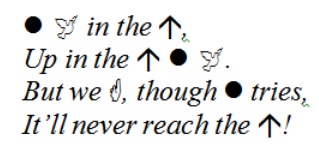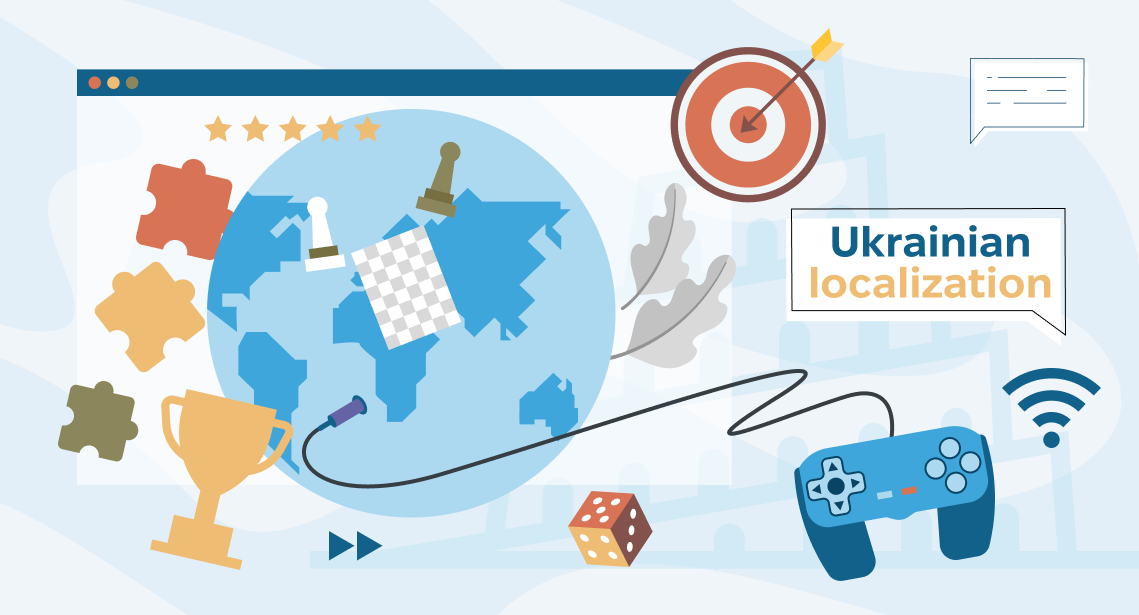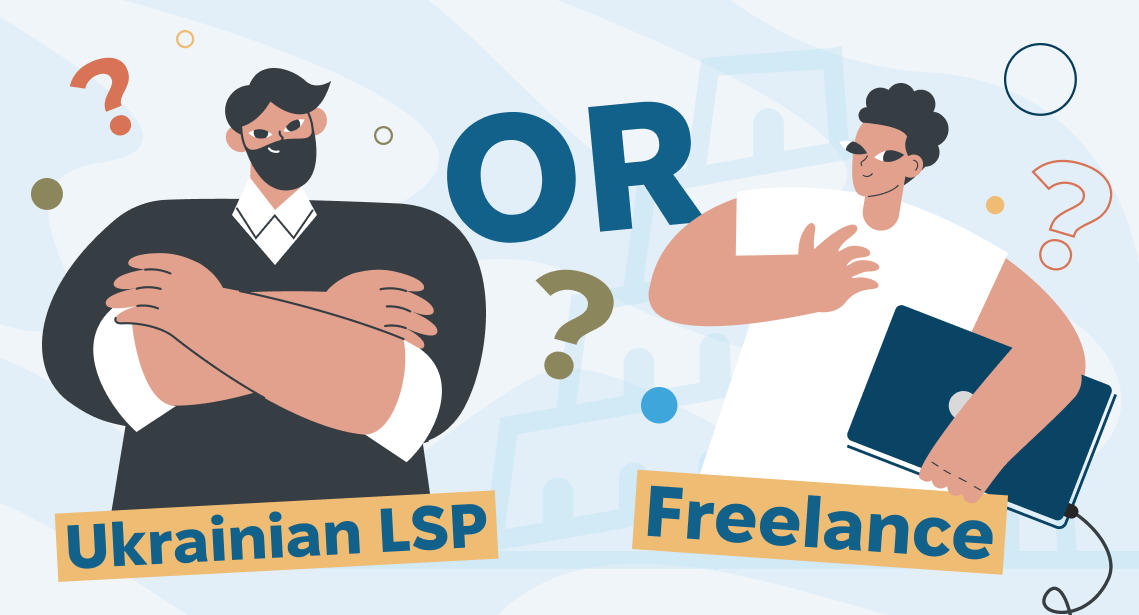QA-fail: how sometimes you can have “Too much of a good thing”

Balloon flies in the skies
In our kindergartens, teachers play a merry game with children. First, all the children sing a rhyme in chorus:
Balloon flies in the skies,
Up in the skies it flies.
But we know, though it tries,
It’ll never reach the skies!
Then, the rhyme is repeated, but the word “balloon” is omitted—the children should show it as a circle using their hands. Then they sing it one more time, but instead of “flies”, they have to flap their arms like a bird. In the next round, they should stretch their arms upwards instead of the word “skies.” And so on—every time, replacing one word with a gesture. As a result, only prepositions are left—the rest of the words are shown using their hands. Those who make a mistake and say a word, lose the game.
Graphically, the final version can be shown as follows:

Children are thrilled about the game. However, when it is “played” by those who create translations, it is not funny for anyone, especially clients, translators, and readers.
* * *
The below story is based on real facts.
Facts
Terminology control is one of the major challenges in localization.
As a rule, serious companies have well-elaborated terminology relating to the products they manufacture, including large glossaries of approved terms. Terminology must be consistent in translations. Inconsistent terminology, at best, will make a bad impression on users. At worst, it may cause, for example, patent proceedings. That’s why special checks are carried out to control terminology. One example of this is that every modern CAT (computer-aided translation) tool now has in-built terminology control functions.
In the English language, all nouns (terms are usually nouns, that’s why we are interested in them above all), with rare exceptions, have only two word forms: singular and plural. The rules of word formation are very simple. But in the Ukrainian language—tough luck!—nouns are declinable also by cases. Moreover, the rules are very complex.
Let’s take, for example, the word scanner. In English, it has only two-word forms: scanner and scanners, i.e. singular and plural. The rest of the meaning is expressed using prepositions and the word order in the sentence.
Now let’s consider a similar Ukrainian word сканер. It has 10 word forms:
сканер, сканера, сканерам, сканерами, сканерах, сканері, сканерів, сканером, сканеру, сканери.
And the verbs may have a hundred-word form.
* * *
The usual translation process looks more or less as follows. For instance, there is a phrase:
To scan a photo, please open the scanner cover and place the photo in the scanner, then press START button.
Also, there is a glossary listing the following meanings:
- scan—сканувати
- scanner—сканер
- photo—фотографія
- button—кнопка
- cover—кришка
The phrase is given to a translator who translates it into Ukrainian. The result would be similar to the following:
Щоб відсканувати фотографію, підніміть кришку сканера й розмістіть фотографію в сканер, після цього натисніть кнопку START.
High-quality translation has been done, the translator is satisfied with their work, there are no mistakes in the text, all terminology has been respected, and even the reverse translation to English sounds like the initial sentence—so they send the text back to the client.
After some time, the text is passed to a QA (quality assurance) manager, who is in charge of the general quality of translation, including terminology.
Two nuances are important here. First, a QA manager is usually in charge of localization to several languages, so Ukrainian is only one of them. Second, a QA manager, as a rule, does not speak all the “coordinated” languages. It’s OK: he or she is a manager and not a linguist. Their task is to organize the quality assurance process, not to proofread the text.
The non-Ukrainian-speaking QA manager is alarmed by the received translation. They have serious doubts: the words look similar to the ones in the glossary but have some differences: the glossary lists “фотографіЯ”, while “фотографіЮ” was used in the text. The glossary term “сканер” has one additional letter: “сканерА”, etc. From their point of view, they’ve found a lot of mistakes that should be corrected.
Next, the QA manager and the translator have a dialog in emails. With every email they are growing more concerned; both are becoming more and more nervous as the deadline is getting closer:
— We have checked your translation and found many mistakes in the terminology. Here is the list where they occur. Please look into them. It is urgent!
— I have checked all the terms — all of them comply with the glossary provided by you. No changes are required. I confirm that the translation is correct.
— Wait a minute; the terms are different from those in the glossary. Look, the glossary lists “кнопкА” and you have “кнопкУ”; and there are many such discrepancies! Please correct all the mistakes and send us the corrected text! It is urgent!
— Do not be concerned, those are not mistakes. All the terms comply with the glossary. However, in the Ukrainian language words can change. It is our grammar. I confirm that the translation is correct.
— But the word “кнопку” is different from the word “кнопка”! And you have such discrepancies in almost every sentence! Please look into it! It is urgent!
— I assure you: these are the same words but in other word forms. No changes are required. I confirm that the translation is correct.
— Could you make all the terms the same as in the glossary? We need to observe the terminology. Please look into it. It is urgent!
— No, it’s impossible. On the contrary, if we put the words into the forms they have in the glossary, we’ll make mistakes. The terminology is observed in the translation. I confirm that the translation is correct.
* * *
Everybody is frustrated. The translator is annoyed that somebody finds faults in their work quality without cause; that they have to spend their time explaining obvious things. The QA manager is dissatisfied that formal requirements are not observed when using the approved terms, which have been agreed upon with all the stakeholders. Nevertheless, the translator is firmly insisting that there are no mistakes in the text. So the QA manager reluctantly has to pass on the text provided to them, grumbling: “All languages are OK, but we always have problems with Ukrainian.”
Brilliant idea
One day some conscientious but—it is important—non-Ukrainian-speaking QA manager has a brilliant idea: why not “lock” the approved translation of the glossary terms into tags?
In other words, all the terms that have the approved translation in the glossaries can be replaced with the numbered tags in the source text before it is sent to the translator. After the translation is received, a dedicated software application will just insert the respective approved translations instead of those tags.
The decision is made—they replace all the approved terms in the source text with the tags having respective numbers. As a result of this replacement, the phrase:
To scan a photo, please open the scanner cover and place the photo in the scanner, then press START button.
Is transformed into the following cryptogram:
To [1] a [3], please open the [2] [5] and place the [3] in the [4], then press START [5].
Here [1], [2], [3] are the term numbers in the glossary. They send the text in such a form to the translator and forbid changing the tags. Next, they receive the translated text from the translator, replace the tags with the respective approved translations from the glossary, and the affair is settled!
Such a procedure will allow killing not two, or even three, but four “birds” with one stone:
- First, quality assurance becomes dramatically easier and faster: instead of long manual checking terminology, it is enough to make a quick automatic check of the tags (tag mismatches).
- Second, because tags are an unedited part of the text, the translation for any term will always only be the approved one: the translator will not be able to use any other translation but the glossary one due to technical reasons.
- Third, not a single term will be missed: the number of tags in the source and the target texts is controlled, so the translator won’t be able to “omit the mandatory” terms and “add unnecessary” ones.
- Last but not least: checks can be automated, and as the tags are usually not considered to be words, as a rule, they are not paid. It means that such a procedure will even save some money.
For this construction worked you simply need to ensure that the tags in both the source and target languages are matched. This job can be entrusted to a cheap computer and not to a costly human. The idea is implemented in the work process.
Brilliant?
Far from it
As you know, the devil is in the detail. The “detail” here is that some languages are inflexional, an unpleasant characteristic for QA. Putting it differently, words in the Ukrainian language can change.
But a tag implies that a word has only one form, the glossary one!
* * *
Having received a text where half of the words were transformed into tags, the translator is astonished and first of all writes a detailed email explaining why such an approach is unacceptable in Ukrainian. He or she warns that such a novelty will only complicate the process. However, the deadline is getting nearer and the process can’t be stopped, so they have to follow the new instructions.
The company forbids the translator to decline the nouns—they can use only the nominative case. Surely the translator can ignore the word forms and translate straightforward, putting the numbered tags instead of words:
Щоб [1] [3], підніміть [5] [2] та розмістіть [3] в [5], після цього натисніть [4] START.
However, after the tags are replaced with the glossary translations, the text will be transformed into the following freak:
Щоб сканувати фотографія, підніміть кришка сканер та розмістіть фотографія в сканер, після цього натисніть кнопка START.
For any Ukrainian-speaking reader, the phrase in this form looks funny, as there are multiple violations of Ukrainian grammar. The “correspondent” translation back to English would sound like:
In order too skan a foto, pleez open the skanner kover end pleis the foto in the skanner, then pres START buton.
Such “translation” is reminiscent of an unedited MT (machine translation). Surely, one cannot deliver the text in such form. The translator realizes this and writes another email begging the company to make an exception for Ukrainian and cancel the new instruction, but receives the standard reply: the instruction is the same for all the languages and it’s too late to change anything.
There is no choice for the translator. But necessity is the mother of invention: so-called descriptors come to help. The descriptors are additional words that “assume” declination:
Щоб від[1] документ «[3]», підніміть деталь [5] пристрою [2] та розмістіть документ «[3]» в пристрої «[5]», після цього натисніть деталь «[4]» START.
Now, after replacing all the tags, the formal requirements concerning terminology are observed, all cases are correct, but the freak has grown up and matured:
Щоб відсканувати документ «фотографія», підніміть деталь «кришка» пристрою «сканер» та розмістіть документ «фотографія» в пристрої «сканер», після цього натисніть деталь «кнопка» START.
The word-for-word translation back to English would sound like:
To make an action “scan” for the document “photo”, please open the part “cover” of the device “scanner” and place the document “photo” in the device “scanner”, then press the part “button” called START.
As the saying goes, the form is correct but the substance is ugly.
What will be the reaction of the buyers to whom this text is addressed, and who will buy this ill-fated scanner? Some of them will return it to the shop silently. Others will post angry comments on websites that collect feedback on products. A third category of buyers will laugh and post some funny blunders on Facebook. However, the first, the second, and the third—all are unhealthy for the manufacturer’s reputation.
This is how, at first glance, a brilliant idea has turned into “We wanted the best, but it turned out as always”.
Epilog
…What happened next?
Next, the translator used all their eloquence and wrote a third, even more detailed email trying to explain that the tag idea is resulting in very negative consequences. The key message is that new rules turn the text into the Benny Hill Show. That worked—the innovative instruction was canceled at last.
And it all began from a mutual striving for increasing translation quality.
So, sometimes you can have too much of a good thing.




